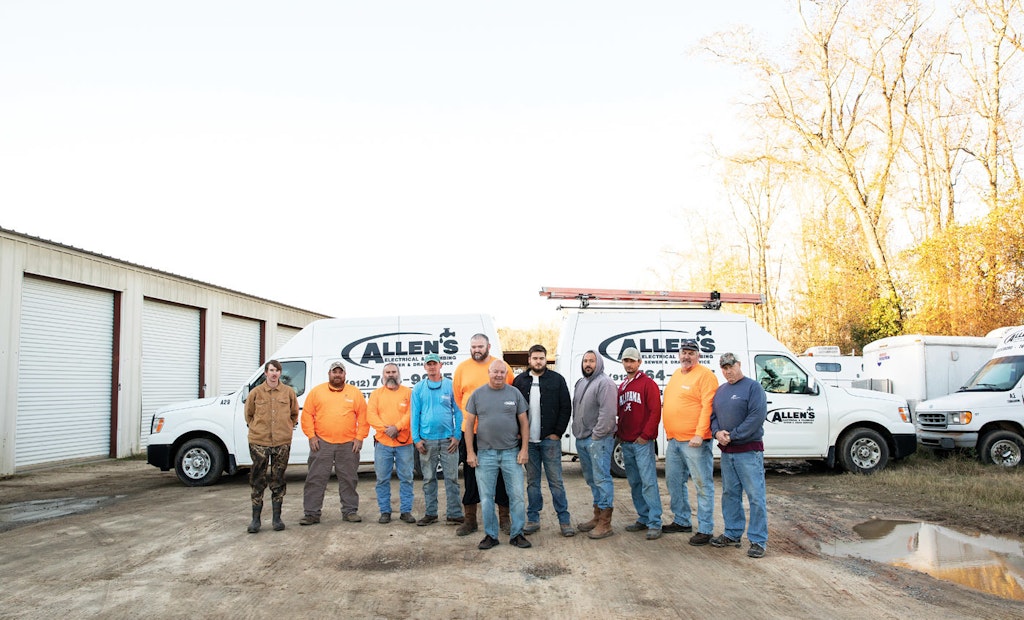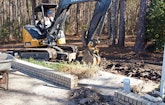
Barney Allen Jr. is shown out front. Members of the Allen’s Environmental Services team include, from left, Justin Bunkley, Clay Lanier, Robert Boyd, Colby Whitaker, Mike Garrett, Josh Good, Jeremy Hyde, Kyle Oglesby, Clint Akins and Gene Thompson. (Photos by Kaylinn Gilstrap)
At Allen’s Environmental Services in Statesboro, Georgia, the recipe for success is easy: Know your business. Barney Allen Jr. has followed this rule for years. Keeping that simple mantra in mind has led him to focus on what he knows he can do well and concentrate on his local area where he can control the quality of work. Success has followed.
A big part of knowing your business is having workers who also know the business. Allen has had trouble finding people like that, and he has come up with his own solution.
He’s had people asking for jobs who claim a wide variety of skills. “And most of these people who come in can’t wind a watch,” Allen says. “And to be honest, there’s very, very, very little common sense anymore. I hate to say that — I honestly do. But the common sense is about gone.
“I had a guy years ago who worked for me as an electrician. You could interview him all day long, and he could tell you how to do something. I put him to work, and I had to redo every job he had done. He could not do anything hands-on.”
Tapping into people power
If you have promising recruits, Allen says you’re better off paying them $100 to spend a few hours with you and demonstrate their abilities. “If they screw it up, you didn’t send them to a customer’s house and lose a customer and over $100,” he says.
Even when he hires people who look like good self-starters, Allen always first sends them with trusted employees to ensure the new hires know what they’re doing before they go out on their own.
Allen hopes to overcome labor issues by continuing to develop his own training center. It’s in a 12-by-30-foot space — and he already thinks he needs to expand. It’s hard to find the free time to finish the project, but it has a kitchen and a row of toilets where he can create problems and then watch technicians solve them.
There is a selection of pipes that he can create clogs in using wooden pieces and other material he purchased from a vendor at the Water & Wastewater Equipment, Treatment & Transport, or WWETT, Show. He also picked up a good deal of free advice. “It’s good that we have people in the industry who will share,” he says.
Allen eventually wants to use a TV to show video from pipe jobs so technicians can see how to use jetters properly and diagnose a variety of problems they will see on the job. “Before I get finished, I’m going to have a video showing a system all the way back to the septic tank,” he says.
He plans to add some water heaters — tanks and tankless. “You have to keep everybody up to date, but there are still homes with old gas water heaters that don’t have electronic ignition,” he says.
Training for septic system installations has to be done on the job, Allen says. He hopes to be able to clear an area outside where he could perform some onsite training.
When he tries to find people, he is not fighting a lack of pay or anything else that he can make up for.
“It’s the interest of the generation. You’re getting people who, honestly, would rather push a button on a computer than have to pick up a pipe wrench,” Allen says. “You can take the best person in the world, but if he doesn’t want to do anything, you can spend all day long, all week long, all year long and he isn’t going to learn anything.”
In his local schools, the best workers are hired before they graduate, he says.
Licensure updates
At the same time that Allen is seeking technically skilled people, he is also advising the state of Georgia on how to revise its licensing. He does this as a member of the On-Site Sewage Certification Committee that is under the state Department of Public Health.
The committee is considering what should be included in a license and whether categories should be split. For example, he says, one license may allow a person to only install septic tanks while drip systems will be under a different part of the license. Maintenance could be another license.
It makes sense to update licensing, given the increasing complexity of onsite technology. Consider drip systems and advanced treatment units, he says. It’s hard to get training on some of the equipment, especially on the second or third installation after the dealer’s representative has gone home. He would like to work with manufacturers to step up training and seminars on use of their equipment, and he hopes to make some headway this year.
Allen runs a diverse company that does onsite installations, pumping, plumbing and municipal sewer work.
ATU systems are few for Allen’s business. Many companies that installed them in the past are no longer active in his area. The same goes for state-required engineers who design more complex systems; he has to look 200 miles away to the Atlanta area to find those designers.
But his technicians routinely work on established ATUs installed by other companies. One technician working on an ATU found a 240-volt line wired to a 110-volt pump. “You get into that kind of stuff, and you can understand the need for state rules,” Allen says.
Now the technology used in his area is shifting back toward mound systems, he says. Although installations are not complicated for him, other challenges keep him and his team busy and give them an edge.
Problem-solvers
“I love problems,” Allen says. “When I say problems, I mean we get into a lot of stuff people can’t deal with, and they don’t have the equipment to deal with it, and we do.” For example, four new public schools were built in his area recently, and Allen’s company was called in to fix all of their wastewater systems after backups.
Many of the lines had concrete in them. The worst was a 10- to 12-foot run of pipe that had been infiltrated by dry concrete mix that cured when water flowed into it. Allen’s technicians milled the pipe and then had to break through a classroom floor to finish the rest because the pipe lost its roundness and the milling equipment was cutting into the pipe. Other pipes had grout in them because of workers washing equipment.
The pipe with the 10-foot blockage was the worst, he says. Concrete entered the pipes when some were broken by workers, but in other cases, no one was admitting how it happened, he says.
Proper troubleshooting involves more than simply having the right equipment; it’s having the knowledge to understand and fix a problem, and that is not a common skill.
“You’re a little bit prouder when you can do something that another (contractor) can’t do,” he says.
His crew was hired to install a grease trap on Jekyll Island, located on the Atlantic Ocean coast about 125 miles from Statesboro. It was a restaurant on a pier, and Allen’s job was to install a grease trap on the shore. Next to the site was a sea wall. When the tide was high, water would come past the sea wall and infiltrate the site.
“We had to wait on the tide, then dig a hole and set the tank,” Allen says. There is a six-hour swing between high and low tides. His crew would show up in the morning while the tide was out, dig a hole and set a tank, then backfill as the tide was coming in. Then they would have to wait until the tide flowed out in order to start the next task.
To keep the plastic tanks in the ground, technicians put 80-pound bags of Sakrete on top of the tanks. When moisture penetrated the bags, the mix would cure and become a permanent weight. Tanks in this situation are always pumped at low tide, too, and then refilled with water before high tide, Allen says.
The water table in his part of Georgia is typically 3 to 4 feet, and in many places, the soil is sugar sand that runs like water, Allen says. Because so many use plastic tanks, ATUs are especially prone to popping out of the ground, he says. “If you have a guy pumping who doesn’t know what he’s doing, then he pumps (the tank) and it about comes out of the ground before he can get back to the truck.”
He and his technicians fixed one of those not too long ago: A customer suffering a wastewater backup had hired a service to pump out an ATU. The technician completely emptied the tank, and when the unit tried to come out of the ground, he put in water and walked away. But the initial shift caused more problems.
“It had changed the grade on the thing by about 6 inches,” Allen says. The plumbing was out of alignment, and the customer called Allen because their pipes were always backed up. Again, it points to the need to know your business, Allen says.
“You can take something like this that’s real simple and make a mountain out of it,” he says.
In the garage
To tackle a variety of work, Allen keeps a diverse group of equipment. It includes:
- 2001 and 2002 Vac-Con combination vacuum trucks for storm and sewer main work; they do a lot of this for municipalities and other contractors
- Vac-Tron Equipment trailer-mounted pumping unit 850 for digging and replacing waterlines
- 1997 Kenworth with a 3,500-gallon steel vacuum tank and Jurop/Chandler pump used primarily for grease traps
- 2001 Freightliner with a 3,000-gallon steel tank and pump from Keith Huber
- 1997 Chevrolet with a 2,500-gallon steel tank and Jurop/Chandler pump
- 1999 International vacuum truck with a 2,500-gallon steel tank and Jurop/Chandler pump
- Case 580 backhoe
- John Deere C50 series mini-excavator
- Volvo EX25 mini-excavator
- Earthforce (Bobcat) backhoe
- Two trailer jetters, one PipeHunter (Texas Underground) and the other from US Jetting
Building a rep
Allen doesn’t do a lot of marketing, yet he keeps all this equipment on the road. He tried listing the company on a home advisory service but ended that arrangement because too many customers just wanted to shop prices. Allen says his people put up with enough of that as it is.
“We have been very fortunate to build a reputation,” Allen says. “It takes a long time to build that. I mean a long, long time. We need to keep our guys up to par about doing a great job and doing it right.”
But he’s done that. He works at it every day, and that’s why Allen’s Environmental Services is thriving.
Incentive program brings higher wages
In his search to do the best for his workers at Allen’s Environmental Services in Georgia, owner Barney Allen Jr. has hit on an idea: an incentive program. It’s helped a lot in retaining good workers, he says.
He’s had the system in place for about a year, and it still needs tuning, and it doesn’t apply to every worker. So far, he’s using it only for plumbing and electrical service technicians. A technician making $15 per hour, for example, can earn an extra $10 an hour on a job. This depends on the technician working efficiently and not taking extra people out with him, which helps to control the company’s cost.
“I always say, ‘If you don’t look after the company, you won’t have a company to work for,’” Allen says.
If two technicians answer the call, the $10 per hour is split between them. If a technician is called back to do a job again, the incentive comes out of his check. “This way the company is not paying extra twice for a bad job,” Allen says.
Vacuum truck drivers aren’t in the program yet because not all of their time is spent on a job; there are those long breaks when a driver is hauling a load of septage to a terminal for dumping.
“I tell my guys, ‘I’m trying to get it to where I can pay you as much as I can,’” Allen says.










